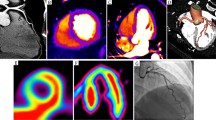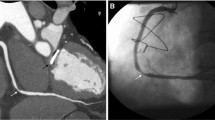Abstract
Non-electrocardiogram-gated contrast-enhanced computed tomography (non-ECG-gated CT) is available in most hospitals where patients with chest and/or back pain are admitted to the emergency department. Although it has been established as the initial diagnostic imaging modality for acute aortic dissection (AAD) and pulmonary thromboembolism (PE), its diagnostic ability for acute coronary syndrome (ACS) in the emergency department has not been elucidated. We retrospectively investigated 154 consecutive patients who required non-ECG-gated CT to differentiate AAD and PE in the emergency department, but had no evidence of them on CT. Furthermore, a subanalysis was performed in the patients who were subsequently suspected of ACS and underwent emergent invasive coronary angiography followed by CT. We evaluated left ventricular enhancement to detect myocardial perfusion deficit by calculating Hounsfield units, and the results were compared with ultimate diagnoses and angiography findings. A perfusion deficit was detected in 43 patients, among whom 26 were ultimately diagnosed with acute myocardial infarction (AMI); 24 patients required emergent revascularization. The subanalysis indicated that perfusion abnormalities corresponded with the territory of the culprit artery in all except one patient. In the remaining 111 patients without perfusion deficit, only two required emergent revascularization, and their levels of creatine kinase MB were not elevated. The sensitivity, specificity, and positive and negative predictive values of non-ECG-gated CT in predicting AMI/emergent revascularization were 93 %, 87 %, 61 %, and 98 %/92 %, 85 %, 56 %, and 98 %, respectively. Non-ECG-gated CT facilitates the diagnosis of ACS and the decision on emergent catheterization, providing information on the ischemic myocardial area by detection of a localized decrease in left ventricular enhancement.





Similar content being viewed by others
References
Storrow AB, Gibler WB (2000) Chest pain centers: diagnosis of acute coronary syndromes. Ann Emerg Med 35:449–461
Rubinshtein R, Halon DA, Gaspar T, Jaffe R, Karkabi B, Flugelman MY, Kogan A, Shapira R, Peled N, Lewis BS (2007) Usefulness of 64-slice cardiac computed tomographic angiography for diagnosing acute coronary syndromes and predicting clinical outcome in emergency department patients with chest pain of uncertain origin. Circulation 115:1762–1768
Takakuwa KM, Halpern EJ (2008) Evaluation of a “triple rule-out” coronary CT angiography protocol: use of 64-section CT in low-to-moderate risk emergency department patients suspected of having acute coronary syndrome. Radiology 248:438–446
Hoshi H, Takagi A, Uematsu S, Ashihara K, Hagiwara N (2013) Risk stratification of patients with non-ST-elevation acute coronary syndromes by assessing global longitudinal strain. Heart Vessels. doi:10.1007/s00380-013-0361-y
Janowitz WR (2001) Current status of mechanical computed tomography in cardiac imaging. Am J Cardiol 88:35E–38E
Pundziute G, Schuijf JD, Jukema JW, Boersma E, de Roos A, van der Wall EE, Bax JJ (2007) Prognostic value of multislice computed tomography coronary angiography in patients with known or suspected coronary artery disease. J Am Coll Cardiol 49:62–70
Fujimura T, Miura T, Nao T, Yoshimura M, Nakashima Y, Okada M, Okamura T, Yamada J, Ohshita C, Wada Y, Matsunaga N, Matsuzaki M, Yano M (2013) Dual-source computed tomography coronary angiography in patients with high heart rate. Heart Vessels. doi:10.1007/s00380-013-0383-5
Arnett JH, Mohajer K, Okon SA (2007) Evidence of acute myocardial infarction on CT. Br J Radiol 80:e219–e221
Zeina AR, Orlov I, Blinder J, Hassan A, Rosenschein U, Barmeir E (2006) Atypical presentation of acute myocardial infarction in a young man diagnosed by multidetector computed tomography. Isr Med Assoc J 8:69–70
Gosalia A, Haramati LB, Sheth MP, Spindola-Franco H (2004) CT detection of acute myocardial infarction. AJR Am J Roentgenol 182:1563–1566
Cerqueira MD, Weissman NJ, Dilsizian V, Jacobs AK, Kaul S, Laskey WK, Pennell DJ, Rumberger JA, Ryan T, Verani MS (2002) Standardized myocardial segmentation and nomenclature for tomographic imaging of the heart: a statement for healthcare professionals from the Cardiac Imaging Committee of the Council on Clinical Cardiology of the American Heart Association. Circulation 105:539–542
Segar DS, Brown SE, Sawada SG, Ryan T, Feigenbaum H (1992) Dobutamine stress echocardiography: correlation with coronary lesion severity as determined by quantitative angiography. J Am Coll Cardiol 19:1197–1202
Thygesen K, Alpert JS, Jaffe AS, Simoons ML, Chaitman BR, White HD (2012) Third universal definition of myocardial infarction. J Am Coll Cardiol 60:1581–1598
Rentrop KP, Cohen M, Blanke H, Phillips RA (1985) Changes in collateral channel filling immediately after controlled coronary artery occlusion by an angioplasty balloon in human subjects. J Am Coll Cardiol 5:587–592
Cury RC, Nieman K, Shapiro MD, Butler J, Nomura CH, Ferencik M, Hoffmann U, Abbara S, Jassal DS, Yasuda T, Gold HK, Jang IK, Brady TJ (2008) Comprehensive assessment of myocardial perfusion defects, regional wall motion, and left ventricular function by using 64-section multidetector CT. Radiology 248:466–475
Halpern EJ (2009) Triple-rule-out CT angiography for evaluation of acute chest pain and possible acute coronary syndrome. Radiology 252:332–345
Schepis T, Achenbach S, Marwan M, Muschiol G, Ropers D, Daniel WG, Pflederer T (2010) Prevalence of first-pass myocardial perfusion defects detected by contrast-enhanced dual-source CT in patients with non-ST segment elevation acute coronary syndromes. Eur Radiol 20:1607–1614
Zhan S, Hong S, Shan–Shan L, Chen-Ling Y, Lai W, Dong-Wei S, Chao-Yang T, Xian-Hong S, Chun-Sheng W (2012) Misdiagnosis of aortic dissection: experience of 361 patients. J Clin Hypertens (Greenwich) 14:256–260
Hagan PG, Nienaber CA, Isselbacher EM, Bruckman D, Karavite DJ, Russman PL, Evangelista A, Fattori R, Suzuki T, Oh JK, Moore AG, Malouf JF, Pape LA, Gaca C, Sechtem U, Lenferink S, Deutsch HJ, Diedrichs H, Marcos y Robles J, Llovet A, Gilon D, Das SK, Armstrong WF, Deeb GM, Eagle KA (2000) The International Registry of Acute Aortic Dissection (IRAD): new insights into an old disease. JAMA 283:897–903
Kitagawa K, George RT, Arbab-Zadeh A, Lima JA, Lardo AC (2010) Characterization and correction of beam-hardening artifacts during dynamic volume CT assessment of myocardial perfusion. Radiology 256:111–118
Busch JL, Alessio AM, Caldwell JH, Gupta M, Mao S, Kadakia J, Shuman W, Budoff MJ, Branch KR (2011) Myocardial hypo-enhancement on resting computed tomography angiography images accurately identifies myocardial hypoperfusion. J Cardiovasc Comput Tomogr 5:412–420
Rodriguez-Granillo GA, Rosales MA, Degrossi E, Rodriguez AE (2010) Signal density of left ventricular myocardial segments and impact of beam hardening artifact: implications for myocardial perfusion assessment by multidetector CT coronary angiography. Int J Cardiovasc Imaging 26:345–354
Mahnken AH, Koos R, Katoh M, Wildberger JE, Spuentrup E, Buecker A, Gunther RW, Kuhl HP (2005) Assessment of myocardial viability in reperfused acute myocardial infarction using 16-slice computed tomography in comparison to magnetic resonance imaging. J Am Coll Cardiol 45:2042–2047
Bae KT (2010) Intravenous contrast medium administration and scan timing at CT: considerations and approaches. Radiology 256(1):32–61
Kidoh M, Nakaura T, Nakamura S, Awai K, Utsunomiya D, Namimoto T, Harada K, Yamashita Y (2013) Novel contrast-injection protocol for coronary computed tomographic angiography: contrast-injection protocol customized according to the patient’s time-attenuation response. Heart Vessels. doi:10.1007/s00380-013-0338-x
Acknowledgments
No financial support was received for this study.
Author information
Authors and Affiliations
Corresponding author
Rights and permissions
About this article
Cite this article
Mano, Y., Anzai, T., Yoshizawa, A. et al. Role of non-electrocardiogram-gated contrast-enhanced computed tomography in the diagnosis of acute coronary syndrome. Heart Vessels 30, 1–8 (2015). https://doi.org/10.1007/s00380-013-0437-8
Received:
Accepted:
Published:
Issue Date:
DOI: https://doi.org/10.1007/s00380-013-0437-8




